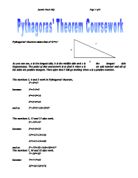Another example is: 5 , 12 , 13
Another Example is: 7 , 24 , 25
We can now tell that numbers in the Pythagorean triplets have to be integers and we can now work out the perimeter and area of the triangles.
To work out the perimeter we use the condition: a + b + c = units
1st triplet - 3 + 4 + 5 = 12 units
2nd triplet - 5 + 12 + 13 = 30 units
3rd triplet - 7 + 24 + 25 = 56 units
To work out the area we use the condition: ½ * a * b = square units
1st triplet - ½ * 3 * 4 = 6 square units
2nd triplet - ½ * 5 * 12 = 30 square units
3rd triplet - ½ * 7 * 24 = 84 square units
We can now put these results into a table:
To find the lengths of the sides of the 4th and 5th triplets I have to try and recognize a pattern :
Shortest Side
3
` + 2
5
+ 2
7
The difference between the numbers of the shortest side seems to be 2. I can now confidently say that the shortest side in the 4th triple will calculate to be 9.
Middle side
4
+ 8
12 +4
+ 12
24
I have found that the difference (2) of the difference (1) is 4,so,
I can estimate that the length of the middle side for triplet 4 will be 40.
Because 12 + 4 = 16
24 + 16 = 40
Longest Side
Here are the lengths of the longest sides:
Middle Longest
4 +1 5
12 +1 13
24 +1 25
The length of the longest side seems to be the length of the middle side +1
Here are my results for the 4th triple:
Length of Length of Length of Perimeter Area
smallest side middle side longest side units sq units
9 40 41 90 180
I can now see if these numbers satisfy the condition a2 + b2 = c2
This is the 4th Pythagorean triple
I can now put this new result into my table and work out the 5th triple
Rules
Smallest side = +2
Middle side = +4 to the difference
Longest side = +1 to middle side
Finding a nth term for the sequences:
Smallest Side
n 1 2 3 4 5
Smallest side 3 5 7 9 11
Difference 2 2 2 2
After studying the grid I have found that the formulae is 2n + 1
Examples : 1 (n) * 2 + 1 = 3
3 (n) * 2 + 1 = 7
5 (n) * 2 + 1 = 11
Middle Side
n 1 2 3 4 5
Middle Side 4 12 24 40 60
Diff 1 8 12 6 20
Diff 2 4 4 4
½ 2nd Diff 2 2
This sequence is quadratic therefore we know it will include and n2. Now I know the sequences ½ 2nd difference is 2 I Know the first part to my formulae will be 2n2.
I will now attempt to work out the 2nd part to my formulae by using a table
I can see now that the difference between n2 and middle side is 2 so I can now say that the formulae will be 2 (n2 ) + 2.
Examples - 2 (1(n)2) + 2n = 4
- 2 (3(n)2) + 2n = 24
- 2 (5(n)2) + 2n = 60







